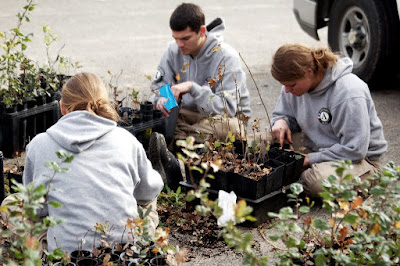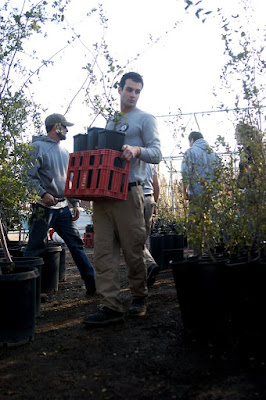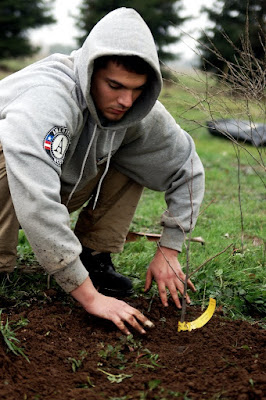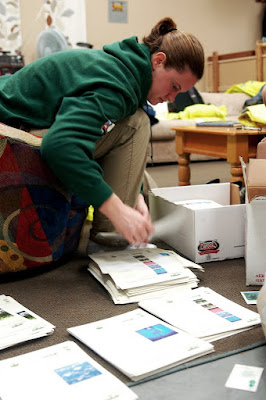It's definitely no joking matter though; one survey found logging to be the job with the second-highest fatality rate in America. This was definitely reinforced by our story-loving instructors, who very excitedly interjected cautionary anecdotes at every opportunity of friends and co-workers who had lost eyes, legs, arms, and/or lives due to careless use of the chainsaw or general inattentiveness. It was definitely frightening to hear at first but also gave us a healthy respect for our tool and craft.
As with our prior training, we spent the first few days of the week in the classroom learning about safety, identifying parts, troubleshooting potential problems, and familiarizing ourselves with basic maintenance and cutting theory. The final three days, however, were spent out in the forest actually getting some hands-on experience. We worked with actual firefighters and personnel from the Bureau of Land Management Mother Lode field office, which manages property near the Eldorado and Tahoe national forests. On our first field day, our training ground was a wildland-urban interface, or WUI, where neighborhoods abut protected natural preserves, raising the stakes in the event of an actual fire. We were just steps away from homes and cement roads, but before us lay a vast tract of untamed brush.



Our only task the first day was simply to learn how to start the chainsaw and cut low-growing shrubs. The tool was a lot heavier than I expected and was tiring on the biceps, and it took some time to get comfortable with the unwieldy saw. Even igniting the engine took a little getting used to, especially for the women in the group since it does require some height and upper body strength. Now, chainsaws are generally very sturdy tools, but we also quickly learned how easily it was for them to malfunction if we didn't handle and maintain them properly.


The chainsaw sliced through the brush like a hot knife through butter, but it was still challenging to remember everything at once: your stance had to be off at an angle away from the whirring blades; you had to watch the surroundings for rocks camouflaged by moss and dirt that might cause kickback; you had to think about how the cut branches would fall so the swamper assisting you can easily pick up the remaining debris.


.JPG)
As I mentioned earlier, the firefighters are very passionate and animated about their stories, so we actually got relatively little work done and spent most of our time being regaled by their adventures. Additionally, since we could only go one at a time on the chainsaw, much of the day consisted of sitting around watching others work.

.JPG)

The next couple of days, we went deeper into the piney woods for some real tree-felling action. We had a really awesome instructor named Aaron, who again burnt plenty of time on stories and was also super patient while we screwed up time and time again. I think he also let us work on a few trees that may have been slightly larger than what we usually are allowed to cut, but it also gave us some room for error. The pines we felled were about 30 to 40 feet tall with a diameter of about 12 to 18 inches. I could think of worse ways to spend a week besides sitting in the shade of the beautiful evergreen forest on a cool, foggy Northern California morning listening to crazy tales of life on the fire line and hearing the buzz of the chainsaw.



There are several different chainsaw tasks we covered after felling a tree. We first learned about limbing, which is when you take the branches off a fallen tree as a kind of clean up.


Once the tree is free of branches, you buck the remaining log into foot-long sections that can be easily transported so as to not obstruct or create additional hazards. This is challenging because you have to be aware of the tension on the log based on how the tree fell so that you don't pinch and bind your chainsaw bar, which is actually a very common mistake and problem.


Finally, our last task was to cut down our very first tree. As I mentioned, there's quite a bit of thought and expertise that goes into this; it's not just slicing right through the trunk. I won't go into the technical details, but I'll just say it wasn't a pretty cut for me the first time around, but I think I improved over the course of the day. The practice cut pictured below is what one of the cuts is supposed to look like. It was made by a teammate; mine definitely wasn't as neat and clean as his.





Finally, here's me cutting down my first tree!


Timber! (...Actually you never say this unless you want to be laughed at by the other sawyers. What you do call is "Tree falling downhill!" and cautiously high tail it outta there.)












































